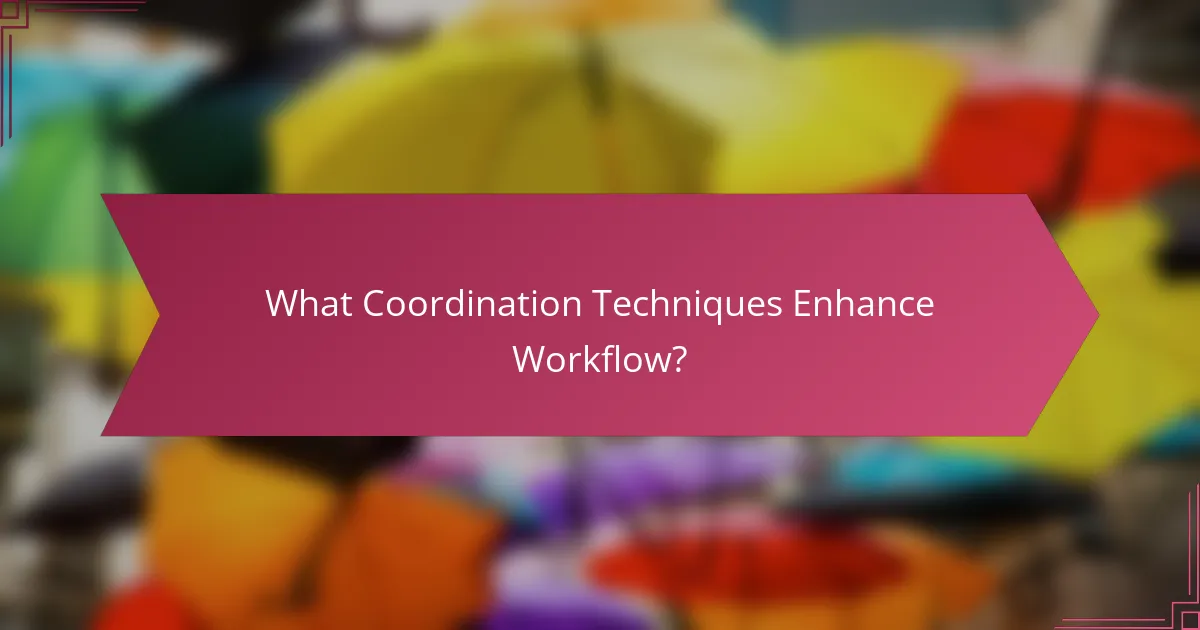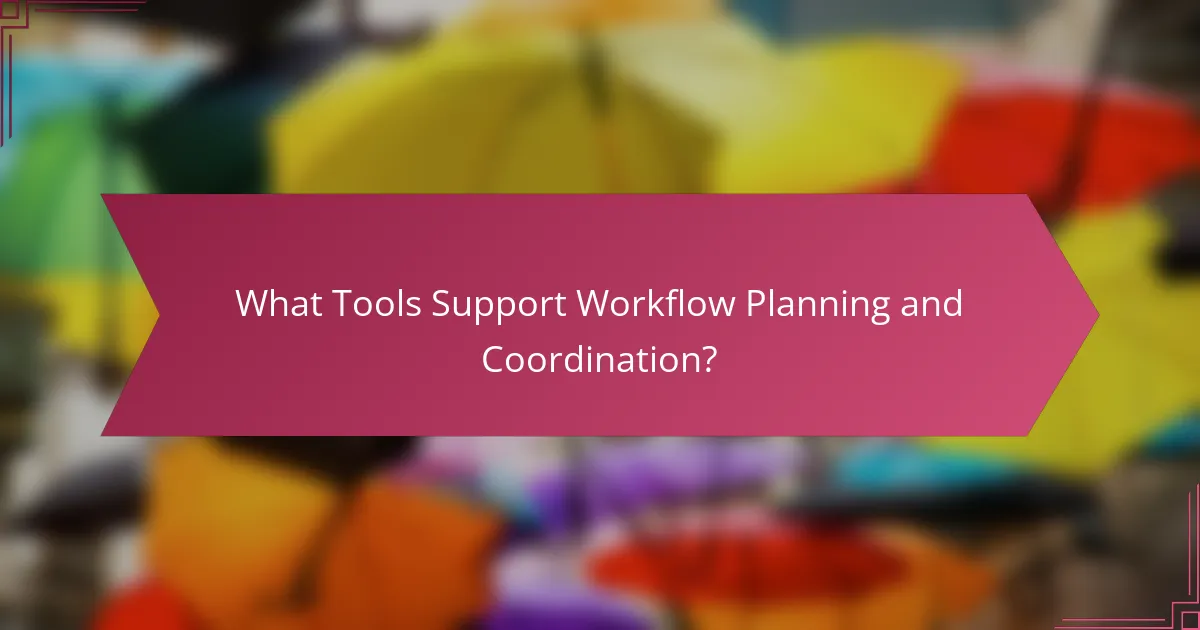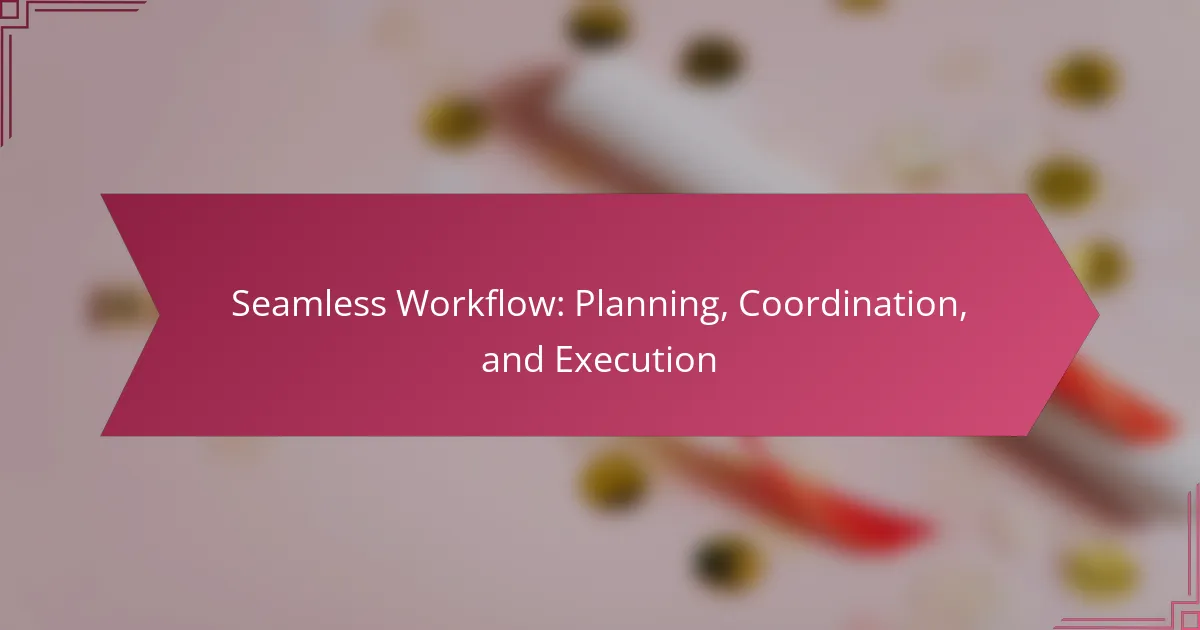Creating a seamless workflow requires meticulous planning, effective coordination, and precise execution. By setting clear objectives and utilizing the right tools, teams can enhance productivity and minimize delays. Implementing techniques such as regular communication and collaborative software ensures that all members are aligned and focused on achieving project goals efficiently.

How to Plan a Seamless Workflow?
Planning a seamless workflow involves setting clear objectives, identifying stakeholders, and utilizing effective tools to ensure smooth execution. A well-structured approach minimizes delays and enhances productivity across teams.
Define objectives clearly
Clearly defined objectives serve as the foundation for a seamless workflow. Establish what success looks like by setting specific, measurable, achievable, relevant, and time-bound (SMART) goals. For example, instead of saying “improve sales,” specify “increase sales by 15% in the next quarter.”
Communicate these objectives to all team members to ensure everyone is aligned and understands their roles in achieving them. This clarity helps prevent misunderstandings and keeps the team focused on common goals.
Identify key stakeholders
Identifying key stakeholders is crucial for effective workflow planning. Stakeholders can include team members, management, clients, and external partners who have a vested interest in the project’s success. Engaging these individuals early in the planning process fosters collaboration and ensures that their needs and expectations are addressed.
Consider creating a stakeholder map to visualize relationships and influence levels. This tool can help prioritize communication efforts and clarify who needs to be involved at each stage of the workflow.
Establish timelines and milestones
Establishing timelines and milestones helps track progress and maintain momentum throughout the workflow. Break down the project into manageable phases with specific deadlines for each milestone. For instance, if a project lasts six months, set milestones at one-month intervals to evaluate progress.
Utilize Gantt charts or similar tools to visualize timelines and dependencies. This approach allows teams to anticipate potential bottlenecks and adjust plans proactively, ensuring a smoother workflow.
Utilize project management tools
Project management tools streamline workflow planning and execution by providing a centralized platform for collaboration. Tools like Trello, Asana, or Microsoft Project can help teams assign tasks, monitor progress, and communicate effectively.
Choose a tool that fits your team’s size and project complexity. For smaller teams, simpler tools may suffice, while larger projects might benefit from more robust solutions with advanced features like reporting and resource allocation.
Document processes and procedures
Documenting processes and procedures is essential for maintaining consistency and efficiency in workflows. Create clear guidelines that outline each step of the process, including roles, responsibilities, and timelines. This documentation serves as a reference point for current and future team members.
Regularly review and update these documents to reflect any changes in the workflow or team structure. This practice ensures that everyone is on the same page and can adapt to evolving project needs without losing productivity.

What Coordination Techniques Enhance Workflow?
Effective coordination techniques are essential for enhancing workflow by ensuring that team members are aligned and tasks are executed efficiently. Techniques such as regular meetings, collaborative software, clear communication, and defined roles can significantly improve productivity and reduce misunderstandings.
Regular team meetings
Regular team meetings foster collaboration and keep everyone informed about project progress and challenges. Scheduling these meetings weekly or bi-weekly can help maintain momentum and ensure accountability.
During these meetings, set a clear agenda and allocate time for each topic to keep discussions focused. Avoid lengthy meetings; aim for 30 to 60 minutes to respect everyone’s time while covering essential updates.
Collaborative software platforms
Using collaborative software platforms can streamline workflow by centralizing communication and project management. Tools like Trello, Asana, or Slack allow teams to track tasks, share files, and communicate in real-time.
Select a platform that suits your team’s size and needs. For smaller teams, simpler tools may suffice, while larger teams might benefit from more robust project management features. Regularly review and update the platform to ensure it meets evolving project demands.
Clear communication channels
Establishing clear communication channels is vital for minimizing misunderstandings and ensuring that information flows smoothly. Define preferred methods for different types of communication, such as emails for formal updates and instant messaging for quick questions.
Encourage team members to use these channels consistently and provide guidelines on response times to foster a culture of prompt communication. Regularly assess the effectiveness of these channels and make adjustments as necessary to improve clarity.
Role assignment and accountability
Clearly defining roles and responsibilities helps ensure that everyone knows their tasks and who to turn to for specific issues. This clarity reduces overlap and confusion, allowing for more efficient task execution.
Implement accountability measures, such as regular check-ins or progress reports, to track individual contributions. Consider using a RACI matrix (Responsible, Accountable, Consulted, Informed) to clarify roles within the team and enhance overall accountability.

How to Execute a Seamless Workflow?
Executing a seamless workflow involves careful planning, effective coordination, and precise execution of tasks. By integrating structured methodologies and continuous monitoring, teams can enhance productivity and achieve project goals efficiently.
Implement project management methodologies
Utilizing project management methodologies like Agile, Scrum, or Waterfall can streamline workflow execution. Each methodology offers distinct advantages; for instance, Agile promotes flexibility and rapid iterations, while Waterfall is suited for projects with clear, sequential phases.
Choose a methodology that aligns with your project requirements and team dynamics. For example, if your team thrives on collaboration and adaptability, Agile may be the best fit, whereas Waterfall might be ideal for projects with fixed timelines and deliverables.
Monitor progress with KPIs
Key Performance Indicators (KPIs) are essential for tracking the progress of a workflow. Establish relevant KPIs, such as task completion rates, budget adherence, and time spent on tasks, to measure efficiency and effectiveness.
Regularly review these KPIs to identify trends and areas for improvement. For instance, if task completion rates are lagging, it may indicate resource allocation issues or the need for additional training.
Adjust plans based on feedback
Incorporating feedback into your workflow is crucial for continuous improvement. Encourage team members to share insights and suggestions regularly, and be prepared to adapt plans accordingly.
For example, if a particular strategy isn’t yielding the expected results, reassess and modify your approach based on team input. This iterative process fosters a culture of collaboration and enhances overall project outcomes.

What Tools Support Workflow Planning and Coordination?
Effective workflow planning and coordination rely on various tools that streamline tasks, enhance communication, and track project progress. Utilizing the right tools can significantly improve team collaboration and efficiency.
Trello for task management
Trello is a visual task management tool that uses boards, lists, and cards to organize tasks. Each card can represent a specific task, allowing teams to move them through different stages of completion. This visual approach helps in quickly assessing project status.
To maximize Trello’s effectiveness, create clear labels and checklists within cards. This ensures everyone understands task priorities and requirements. Regularly updating the board can prevent bottlenecks and keep the workflow smooth.
Slack for team communication
Slack is a messaging platform designed for team communication, offering channels for different projects or topics. It allows real-time messaging, file sharing, and integration with other tools, making it a central hub for team discussions.
To enhance communication, create dedicated channels for specific projects or teams. Encourage team members to use threads for focused discussions, which helps keep conversations organized. Be mindful of notification settings to avoid overwhelm while ensuring important messages are seen.
Asana for project tracking
Asana is a project management tool that helps teams track progress and manage tasks effectively. It allows users to create projects, assign tasks, set deadlines, and monitor overall project timelines. This visibility helps teams stay aligned and accountable.
Utilize Asana’s timeline feature to visualize project schedules and dependencies. Regularly review project dashboards to identify any delays or issues early. Encourage team members to update task statuses frequently to maintain an accurate overview of progress.

What Are the Best Practices for Workflow Execution?
Effective workflow execution relies on structured processes, clear communication, and continuous evaluation. Implementing best practices ensures that teams can adapt quickly and maintain productivity throughout various projects.
Continuous improvement cycles
Continuous improvement cycles involve regularly assessing and refining workflows to enhance efficiency. This practice encourages teams to identify bottlenecks and implement solutions iteratively, fostering a culture of ongoing enhancement.
To establish effective cycles, consider using methodologies like Plan-Do-Check-Act (PDCA) or Agile sprints. These frameworks allow teams to set specific goals, test changes, evaluate results, and adjust accordingly, leading to sustainable improvements over time.
Regular performance reviews
Conducting regular performance reviews is essential for monitoring workflow effectiveness and team productivity. These reviews help identify strengths and weaknesses, allowing for timely adjustments to processes and resource allocation.
Set a schedule for performance reviews, such as quarterly or bi-annually, and focus on key performance indicators (KPIs) relevant to your workflow. This could include metrics like task completion rates, turnaround times, and team satisfaction scores, which provide valuable insights for future planning.
